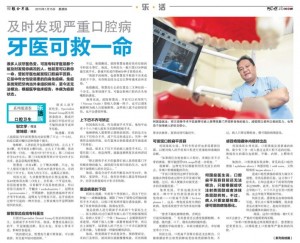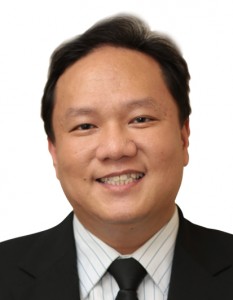 This article first appeared in the January 15th, 2015 issue of Lianhe Zaobao LOHAS. For the benefit of those who missed the article, or who cannot access the publication in Chinese, we have summarized the content of the article below.
This article first appeared in the January 15th, 2015 issue of Lianhe Zaobao LOHAS. For the benefit of those who missed the article, or who cannot access the publication in Chinese, we have summarized the content of the article below.
A lot of people draw back in fear at the mention of seeing a dentist. However, a dental specialist is someone who may be able to detect your health issues in time to possibly save your life. For example, a dentist can detect Oral Lichen Planus (OLP) on the walls of your oral cavity. OLP is an autoimmune disease that middle aged women are more susceptible to, where the immune system mistakes one’s gums as foreign cells. With no cure to date, and according to medical clinical reports, this is a pre-cancerous condition.
Dr Ho Kok Sen, dental specialist in oral & maxillofacial surgery with Specialist Dental Group®, said that many people recoil at the mention of a dentist, which could be due to unpleasant past experiences with extractions or dental fillings.
Dr Ho revealed that he once had a patient who recounted to him, his tormenting wisdom teeth extraction which lasted for more than an hour, and resulted in the development of a swollen face the next day.
He explained that humans have milk teeth which consist of 8 molars – 2 on the upper right and 2 on the upper left, and another 2 each on the correspondingly lower right and left. Permanent teeth, on the other hand, are made up of 12 molars – 3 on the upper right and 3 on the upper left, and another 3 each on the correspondingly lower right and left. The permanent molars develop in sequence, with the first pair of molars developing when one was between 5 to 7 years old; the second molars at about 10 to 14 years old, and the third molars, also known as the wisdom teeth, will develop when one is between 17 to 25 years old.
There will be a total of 4 wisdom teeth, 2 on each of upper and lower jaws. However, the growth of wisdom teeth differs for individuals; some may experience their teeth erupt at 16 years old, some may only develop wisdom teeth at 40 odd, 50 years old, and some people’s wisdom teeth may never grow out – all of which is normal.
Dr Ho said that most wisdom teeth grow at about 45 degree in a forward position, resting on the second molar, creating an angle on the nook of the crown. Food tends to get stuck easily in this nook, making it difficult to clean thoroughly with daily brushing. This in turn can cause tooth decay, dental root inflammation (pulpitis), gum inflammation (pericoronitis), swollen gums, as well as ulcers and irregular dentition among other dental issues. Crown periodontal disease is different from gum inflammation, it is a complication caused by the process of tooth eruption, mainly characterized by inflammation of soft tissue around the crown.
Seek A Dental Specialist For Wisdom Teeth Extraction
Dr Ho Kok Sen is an Oral & Maxillofacial Surgeon in Specialist Dental Group®. He says, as wisdom teeth are one’s last set of teeth to develop, where the cells in the crown are active and prone to cysts, often bringing discomfort and affecting one’s daily diet.
“My advice is not to keep your wisdom teeth, and to extract whenever possible, and to do it when one is young.”
However, Dr Ho reminded that, wisdom tooth extraction is best done by an experienced dental specialist. He said that a dental specialist usually only takes about 15 minutes to complete the procedure, while a general dentist may probably need 60 minutes to extract the wisdom tooth.
“I have come across various cases where the dental roots of the wisdom teeth are not properly extracted or not thoroughly extracted. Some of them come to the clinic to seek help for the swelling and pain after extraction.”
Dr Ho cautioned, that when the wisdom tooth is growing between the trigeminal nerves, extraction must be handled properly; a poor extraction may affect sensations of the tongue and lips in the oral cavity.
He added on, a dentist can utilize the use of laughing gas (Nitrous Oxide) to allow patients to go into a temporary light sleep when extracting wisdom teeth, or opt to engage an anesthetist to administer anesthetic. In this way, patients do not have to fear the surgery, and will not have any pain.
Misaligned Jaws Can Be Corrected
Dr Ho Kok Sen said that as an Oral & Maxillofacial Surgeon, he sees about 8 to 10 patients annually who seek treatment for jaw surgeries.
He explained the various reasons where patients may require jaw corrections – some may be born with misaligned upper and lower jaws or with chins that are either short or too long, while others could be due to trauma such as from playing basketball which result in facial injuries, or car accidents which fracture the lower jaws.
Dr Ho said that many patients who had jaw surgeries will only need to be admitted into the hospital for 3 days, after which they are required to rest for 2 weeks, and they will gradually be able to return to a normal diet and regain speaking ability.
“Correcting misaligned jaws not only helps patients regain chewing abilities with their incisors, but also alleviates the burden on their premolars and molars. It also increases their overall levels of confidence when socialising.”
Dr Ho mentioned that the most suitable age for correcting misaligned jaws will be between 16 to 18 years old as they can heal faster and often with good results. However, there are also some patients who only undergo the procedure at 40 years of age and above, when they have the financial ability to do so.
Reconstructing Jaws for the Medically Compromised
Dr Ho Kok Sen revealed that he had a foreign patient last year who had a tumor in the lower jaw which turned out to be Ameloblastoma. He had to remove 70% of his lower jaws, after which he went through a failed reconstructive surgery, which caused his oral cavity and neck to be infected and have pus. This affected his diet, speaking ability, and distorted his face shape.
He was one of the multi-disciplinary team of medical specialists who performed the procedure for the patient. After a thorough clinical examination with patient’s lower jaw and facial structure, a titanium palate was placed, before taking a piece of the patient’s left fibula bone to fabricate into a jaw bone, before placing in dental implants. Through this procedure, the patient’s lower jaws healed in 3 ½ months, and the patient could chew and speak as per normal.
Dr Ho said that the complexity of reconstructive jaw surgeries varies with the situations. Some cases like bone fractures only need to be set back into position and recovery will slowly take place, while other more complex cases may require multiple patch ups, taking up to years for recovery.
Discovery of Abnormal Oral Tissues
Dr Ho Kok Sen said that a dental specialist clinic may often acquire new equipment to carry out more detailed and accurate clinical diagnosis.
“When we conduct a clinical oral examination on a patient and discover some unusual ulcers, we can use VELscope for further examination.”
Dr Ho explained that this optical instrument uses the characteristics of fluorescence wavelength to detect the existence of oral cancer cells.
“Dentists can use this handheld device during a routine examination for their patients to detect suspicious cells early. Patients can then take the next timely step to do a biopsy.”
Dr Ho added that with VELscope, a dentist may also detect another condition which middle aged women are more susceptible to – an autoimmune disease, oral lichen planus (OLP). This is a disorder of the autoimmune system in the body where the cells in the body are unable to distinguish between foreign cells and one’s own cells, and reject one’s one cells.
“Patients with this disease are unable to eat sour and spicy foods, as a localized pain may be triggered.” Some patients may even feel that their mucous membrane (tissue on the inside of your cheek) is rough, experience numbness, a burning sensation, dry mouth, and the occasional itchy throat.
According to scientific studies, this is a pre-cancerous condition; however, the chance of this becoming cancerous is less than 1%.
Dr Ho said that at the moment, there is no cure for OLP, but one can try to relief the symptoms by steroid injections or application of topical steroid medicine. However, with regular medical check-ups, patients can prevent the condition from getting worse.
Hidden Cold Sores in the Body
Dr Ho Kok Sen added that oral ulcers are a common issue and one third of patients have experienced some kind of oral discomfort before. Ulcers usually develop around the lips, gums, inner cheeks (buccal), upper jaws and tongue.
Dr Ho pointed out that there are different types of ulcers, and the most commonly seen are aphthous ulcers and cold sores, also known as herpes ulcers.
The causes for aphthous ulcers are largely unknown; some may be caused by abrasion, which in turn is linked to xerostomia (dry mouth condition). There are as many as 500 types of commonly used drugs that are known to cause dry mouth. In addition, there are also other serious medical conditions which can cause dry mouth. Dry mouth not only causes ulcers, it can also cause gum disease and tooth decay.
Dr Ho said that cold sores can be due to herpes disease, and often develops outside the oral cavity, e.g. on the lips. Many patients got infected when they were young but did not develop symptoms, only to have these cold sores erupt unexpectedly in adulthood.
He said that most mouth ulcers heal on their own in 7 to 10 days, or in about 2 weeks for more serious cases.
“If the mouth ulcers do not heal after two weeks, patients are advised to see a doctor to eliminate the risk of oral cancers or other serious medical conditions.”
 Dr Ho Kok Sen is an Oral & Maxillofacial Surgeon with Specialist Dental Group®. Dr. Ho is a mentor, lecturer and examiner to students in the Graduate Diploma in Dental Implantology course at the National University of Singapore. Dr. Ho is a fellow of the Royal Australasian College of Dental Surgeons and the Academy of Medicine Singapore. He has a special interest in dental implants, jaw surgery, bone grafting and complex extractions. For more information, visit www.specialistdentalgroup.com.
Dr Ho Kok Sen is an Oral & Maxillofacial Surgeon with Specialist Dental Group®. Dr. Ho is a mentor, lecturer and examiner to students in the Graduate Diploma in Dental Implantology course at the National University of Singapore. Dr. Ho is a fellow of the Royal Australasian College of Dental Surgeons and the Academy of Medicine Singapore. He has a special interest in dental implants, jaw surgery, bone grafting and complex extractions. For more information, visit www.specialistdentalgroup.com.
Source: © Singapore Press Holdings Limited. Reproduced with permission





